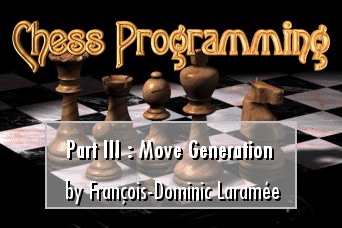11/10 - 11/12 @ Montréal, Canada
12/5 - 12/7 @ Shanghai, China
12/24 - 12/27
2/28 - 3/4 @ San Francisco, CA
More events...
2406 articles in the reference section.
Help us fight cancer!
Join SETI Team GDNet!

|
Last month, I finished Part II of this series by introducing a data structure which pre-processes and stores most of the work related to chess move generation. This time, I will return to the topic in more detail, examining the two major move generation strategies and explaining how to choose between them for a given application. The Early Days: Forward PruningIn 1949 (yes, really), Claude Shannon described two ways to build a chess-playing algorithm:
At first, the second alternative seemed more likely to succeed. After all, this is how human players do it, and it seems logical to assume that looking at only a few moves at each node will be faster than looking at all of them. Unfortunately, the results disproved the theory: programs using selective search just didn't play very well. At best, they achieved low to mid-level club player ratings, often committing humiliating blunders at the worst possible time. Beating a world champion (or even playing reasonably well on a consistent basis) was beyond their reach. The problem is that, for a "best move generator" to be any good, it has to be almost perfect. Suppose that a program is equipped with a function that looks for the 5 best moves in a position, and that the objective best move is among those 5 at least 95% of the time. (That, by the way, is a big assumption.) This means that the probability that the generator's list will always contain the best choice at all times, during a 40-move game, is less than 13%. Even a god-like generator with 99% accuracy will blunder at least once in about a third of its games, while a more reasonable 90%-accurate function will play an entire game without messing up less than 1.5% of the time! In the mid 1970's, the legendary Northwestern team of Slate and Atkin decided to do away with the complicated best-move generator; it turned out that the time they saved in avoiding costly analysis during move generation was enough to cover the added expense of a full-width search (i.e., examining all possible moves). To all intents and purposes, this discovery buried forward pruning for good. Botvinnik's work
|
|
|
|
|